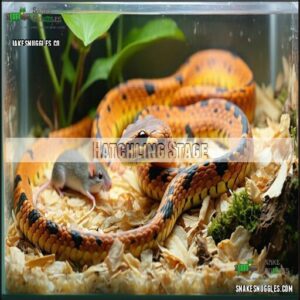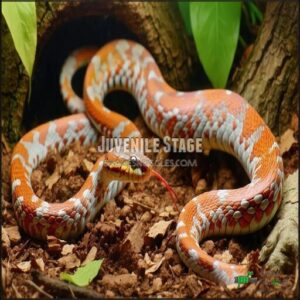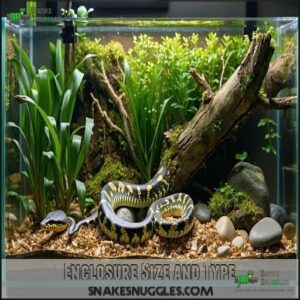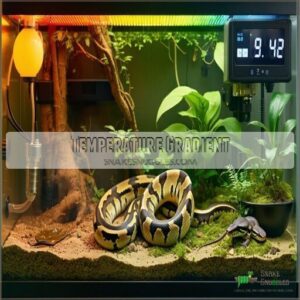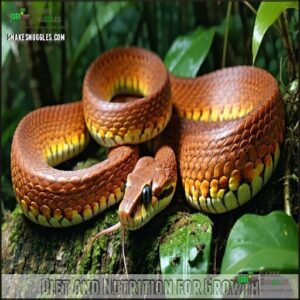This site is supported by our readers. We may earn a commission, at no cost to you, if you purchase through links.

Females are often a bit longer than males, but either way, they’re manageable for most owners.
Their growth depends on factors like genetics, diet, and habitat conditions—like temperature and humidity.
As babies, they start small, around 10-15 inches, but with the right care and consistent feeding, they grow quickly in their first year.
Adults usually weigh 1-2 pounds, making them easy to handle.
Want your corn snake to thrive? Keep their enclosure cozy and their meals just right, and you’ll see them hit their healthy size.
Table Of Contents
- Key Takeaways
- Corn Snake Size Overview
- How Big Do Corn Snakes Get
- Factors Affecting Growth Rate
- Corn Snake Growth Stages
- Ideal Habitat for Growth
- Diet and Nutrition for Growth
- Maximizing Corn Snake Growth
- Frequently Asked Questions (FAQs)
- How long do corn snakes grow?
- How big is a corn snake?
- How big does a 6 month old corn snake get?
- How much does a female corn snake weigh?
- How long does a corn snake last?
- What is the growth pattern of a male corn snake?
- Is a 40 gallon tank big enough for a corn snake?
- Are corn snakes friendlier than Ball pythons?
- Do corn snakes grow continuously throughout life?
- Can corn snake size vary by region?
- Conclusion
Key Takeaways
- Corn snakes usually grow 3-5 feet long, but some can hit 6 feet with proper care.
- Females tend to be longer than males, with most growth happening in the first two years.
- Provide a well-regulated habitat with the right temperature, humidity, and diet to support healthy growth.
- Adult corn snakes typically weigh 1-2 pounds and thrive in enclosures of at least 40 gallons.
Corn Snake Size Overview
Corn snakes are medium-sized, non-venomous snakes that usually grow between 4 to 6 feet long as adults.
Corn snakes grow 4-6 feet, making them a perfect, non-venomous pet that’s easy to handle and care for.
Their size depends on factors like diet, genetics, and proper care, making them a manageable and popular choice for pet owners, due to their non-venomous nature.
Average Length and Weight
Adult corn snake length typically ranges from 4 to 5 feet, though most stay closer to 3.5 to 4.5 feet.
The average corn snake size also includes a weight of around 900 grams, with some reaching 2 pounds.
Growth milestones, like sex differences, reveal females often outgrow males.
Measuring guarantees accuracy when tracking a full-grown corn snake’s size. A healthy snake will have good muscle tone and body shape, regardless of exact weight, with good muscle tone, healthy snake, and exact weight being key factors.
Growth Rate and Development
Corn snake growth rate is fascinating.
Corn snake growth is a journey—from tiny hatchlings to impressive adults, with each stage revealing fascinating changes and unique care needs.
Hatchlings grow rapidly, reaching about 8–12 inches.
Juvenile growth is faster, influenced by diet and temperature, with snakes often hitting 35–40 inches by one year.
Adult size varies between 4–6 feet, depending on growth factors like genetics.
Sexual dimorphism means females are often larger.
Snake development slows after two years, and this is influenced by genetics and diet.
Factors Influencing Size
Corn snake growth depends on many factors beyond just time. A mix of nature and nurture shapes their size.
Here’s what matters most:
- Genetic Predisposition: Genetics set growth potential.
- Dietary Needs: A well-fed snake grows better.
- Enclosure Size: Cramped tanks limit movement.
- Temperature Gradients: Proper heat boosts metabolism.
- Environmental Impact: Stress stunts development.
How Big Do Corn Snakes Get
Regarding how long corn snakes grow, their size depends on a mix of factors like genetics and care. Most full-grown corn snakes measure around 4-6 feet long, though 5 feet is less common, and anything over 5.5 feet is pretty rare.
Their growth timeline typically spans 2-3 years, with faster growth happening in their first year. Size genetics and gender differences also play a part—females tend to be longer than males on average.
Captive corn snakes can thrive given proper environmental conditions.
Here’s what you can expect:
- Hatchlings: 8-12 inches long.
- Six-month juveniles: 20-30 inches.
- One-year-olds: 35-40 inches.
- Adults: 4-6 feet, with uncommon sizes reaching 6 feet.
- Maximum corn snake size is rare but fascinating to observe, and their growth timeline is an important aspect to consider, with faster growth in the first year, and size genetics playing a significant role, including gender differences that make females tend to be longer, and understanding proper environmental conditions is crucial.
Factors Affecting Growth Rate
Your corn snake’s growth depends on several key factors like diet, temperature, and humidity.
By controlling these conditions and providing proper care, you can guarantee healthy development and reach their full size potential.
Temperature Fluctuations
Keeping snake temperature steady makes all the difference in corn snake growth.
Big temperature swings can slow digestion rates, disrupt activity levels, and even cause shedding issues or weaken the immune response.
Aim for a warm basking spot around 88°F–92°F and a cool side down to 75°F.
Temperature regulation keeps corn snakes active, healthy, and closer to their full size, which is crucial for their overall well-being, and maintaining a steady temperature is key to preventing issues such as shedding problems, and it supports healthy growth.
Humidity Levels
Humidity levels are essential for your snake’s health.
Too low, and shedding problems arise; too high, and respiratory infections may follow.
Aim for 40–50%.
Here’s how:
- Monitor humidity with a reliable gauge.
- Use misting techniques daily for hydration needs.
- Add a humid hide for shedding ease.
- Avoid water bowl spills.
- Adjust levels seasonally.
Diet and Nutrition
Mice make up most of a corn snake’s diet. Feed prey slightly wider than their mid-body to avoid issues.
Hatchlings eat every 5-6 days, juveniles weekly, and adults every 1-2 weeks. Proper feeding frequency prevents obesity.
Whole prey offers balanced corn snake nutrition, but occasional calcium supplementation helps. Vitamin D3 is also essential for calcium absorption.
Always provide fresh water; hydration is indispensable for corn snake growth, and a balanced diet including proper feeding frequency is crucial.
Genetics and Environment
While diet matters, corn snake genetics and environment play a huge role in snake growth factors.
Genetic potential determines size heritability, but the environmental impact can’t be ignored.
Growth optimization depends on:
- Morph influence: Unique traits affect corn snake size.
- Habitat quality: Temperature and humidity promote healthy growth.
- Balanced care: Both genetics and surroundings influence snake size variation.
Corn Snake Growth Stages
Understanding corn snake growth stages helps you track their progress from tiny hatchlings to impressive adults.
Each stage has unique care needs, so it’s important to monitor their size and adjust their habitat and diet as they grow, which involves complete concepts of care and unique needs.
Hatchling Stage
A hatchling corn snake starts off small, usually 8–12 inches long, making their initial size perfect for smaller enclosures.
Their first shed happens within days of hatching, so verify the humidity is balanced.
These tiny snakes thrive on appropriately sized pinky mice. Gentle handling helps them adjust, but a secure enclosure setup prevents accidental escapes during this delicate snake growth stage, which requires gentle handling and a secure enclosure.
Juvenile Stage
In the juvenile stage, your corn snake grows quickly, reaching 20-30 inches by six months.
You’ll notice frequent shedding as it develops.
Be sure to:
- Upgrade its enclosure to accommodate its size.
- Monitor growth regularly using a corn snake growth chart.
- Handle it gently 2-3 times weekly to build familiarity.
They require frozen-thawed pinky mice for proper nutrition. Healthy snake growth stages are supported by proper care.
Adult Stage
Once your corn snake reaches the adult stage, it’s likely full grown at 4-6 feet.
Females tend to be larger, showing sexual dimorphism. Breeding adults usually weigh around 900 grams.
Adult size depends on care, genetics, and environment. A healthy adult has a lifespan of 15-20 years.
Watching its growth stages unfold is a rewarding part of ownership!
Ideal Habitat for Growth
Creating the perfect habitat helps your corn snake grow strong and healthy. You’ll need the right enclosure size, temperature gradient, and humidity to keep them thriving.
Enclosure Size and Type
A full-grown corn snake needs an enclosure matching its size, at least 40 gallons.
Glass or plastic tanks work best.
Add hiding spaces to reduce stress, use safe substrate for burrowing, and include enrichment items like climbing branches to keep it engaged.
A similar sized enclosure, such as a 40-50 gallon enclosure, is suitable for adult rosy boas.
Clean the snake tank regularly to maintain a healthy environment and prevent illness.
- Tank Material: Durable glass or plastic.
- Hiding Spaces: Essential for security.
- Substrate Choice: Aspen shavings or paper-based bedding.
- Enrichment Items: Climbing branches and decor.
Temperature Gradient
Corn snakes thrive with a proper temperature gradient. Set the cool side at 75–82°F and the basking area at 88–92°F.
Use heating methods like heat lamps or mats with thermostat control for stability. A suitable gradient impacts activity, digestion, and corn snake growth.
For consistent and safe heating, consider a reptile thermostat option. Without it, even a full-grown corn snake may struggle.
Here’s a quick reference table:
Humidity and Lighting
Let’s talk humidity and lighting for your snake’s comfort.
Keep humidity at 40-50% to avoid shedding issues and respiratory problems. Too dry, and shedding gets tricky; too damp, and mold becomes an uninvited roommate.
Use adjustable lighting types to maintain temperature balance. Proper light and humidity create health benefits that promote ideal corn snake growth, inside the right corn snake enclosure size.
You can find reptile humidity controllers to help maintain these ideal levels.
Diet and Nutrition for Growth
You’ve got to feed your corn snake the right-sized meals to support healthy growth and maintain their energy.
A diet of appropriately sized mice, offered every 7–10 days, guarantees they get the nutrients they need to thrive.
Food Sources and Frequency
If your snake’s habitat is set, you’ll need the right feeding schedule for growth.
Stick to prey size slightly wider than the snake’s body. A diet of mice works best, with these tips:
- Hatchlings: Feed every 5-6 days.
- Juveniles: Weekly feedings.
- Adults: Every 1-2 weeks.
Watch for obesity risks. Occasional supplementation supports nutrition. Many owners purchase their snake food online.
Feeding Techniques and Tips
Always choose prey size slightly wider than your snake’s middle.
Feed frozen mice, thawed fully, to avoid injury or stress. Use tongs to mimic movement, encouraging natural feeding behavior.
Avoid handling after feeding; snakes need time to digest, or regurgitation may occur.
A feeding schedule—adjusted for age—supports corn snake growth and helps your snake reach full size.
Nutritional Requirements
How do you guarantee your corn snake thrives? Provide prey size that matches its thickest body part.
Feeding frequency changes with age—weekly for juveniles, every 10-14 days for adults.
Supplementation needs include occasional calcium dusting to avoid deficiencies.
Hydration is essential, so always offer fresh water. Balance your corn snake diet to prevent obesity, supporting ideal growth, weight, and size.
Maximizing Corn Snake Growth
If you want your corn snake to reach its full potential, providing the right care is essential.
Focus on proper feeding, habitat conditions, and regular monitoring to help them grow strong and healthy.
Proper Care and Handling
Handling your corn snake correctly is key to keeping it stress-free and healthy.
Support its full body, move calmly, and avoid sudden gestures. Limit handling during shedding or after meals to reduce stress.
Regularly cleaning the enclosure promotes hygiene and encourages proper corn snake growth.
Safe handling guarantees your full-grown corn snake thrives while building trust and making care easier.
Health Checks and Monitoring
Regular health checks keep your corn snake thriving. Look for shedding problems, scale issues, or unusual respiratory signs. Parasite prevention and weight monitoring help track corn snake growth and overall health.
A healthy snake’s size, body weight, and behavior should stay consistent.
- Inspect weekly: Check scales, eyes, and mouth.
- Track weight: Use a digital scale.
- Observe behavior: Note eating, hiding, or unusual activity.
Minimizing Stress and Promoting Wellbeing
Keeping your corn snake’s stress low is key to its wellbeing and growth.
A quiet environment, secure enclosures, and enriching activities make all the difference.
Recognize stress signs like hiding or lack of appetite.
Safe handling builds trust, while consistent care helps your snake thrive.
For a full-grown corn snake, reducing snake stress guarantees healthy growth and promotes happiness in their habitat.
Frequently Asked Questions (FAQs)
How long do corn snakes grow?
Imagine a rope that keeps growing—corn snakes reach 4-6 feet long, with rare giants hitting 6 feet.
Females tend to be larger, and most growth happens within their first two years.
How big is a corn snake?
Corn snakes can grow up to 5-6 feet long, though 3-5 feet is more common.
Females are usually larger than males.
Most reach their full size, about the length of a broomstick, by age three.
How big does a 6 month old corn snake get?
Ever wondered how much a 6-month-old corn snake grows?
By this age, they typically stretch to about 20-30 inches long and weigh 25-30 grams.
That’s quite the upgrade from their tiny hatchling days!
How much does a female corn snake weigh?
Female corn snakes usually weigh around 900 grams when fully grown, which takes about 2-3 years.
Their size depends on genetics, diet, and habitat, but they’re generally heavier than males thanks to their larger frames.
How long does a corn snake last?
A corn snake’s life is like a slow-burning candle, lasting 15-20 years with proper care.
Keep their habitat cozy, meals consistent, and stress low to enjoy a long, healthy friendship with your scaly companion.
What is the growth pattern of a male corn snake?
Male corn snakes grow rapidly in their first year, reaching around 3 feet by 12 months. Their growth slows after that, maxing out at 4–5 feet in 2–3 years with proper care.
Is a 40 gallon tank big enough for a corn snake?
A 40-gallon tank works well for most adult corn snakes, offering space to stretch, slither, and snooze.
Make certain it’s secure, with proper heating and hiding spots—it’s like their tiny jungle gym!
Are corn snakes friendlier than Ball pythons?
Both corn snakes and ball pythons are docile, but corn snakes are often considered slightly more active and curious.
If you want a snake that’s friendlier and easygoing, either choice works well for beginners.
Do corn snakes grow continuously throughout life?
Think of corn snakes like slow-growing trees—they don’t grow endlessly.
Most of their growth happens in the first few years, then slows down substantially.
Once they’re adults, they pretty much stay the same size.
Can corn snake size vary by region?
Yes, size can vary slightly by region due to genetics and environmental factors.
Warmer climates may lead to faster growth, while cooler areas might slow it down a bit.
Still, their range stays fairly consistent.
Conclusion
Caring for a corn snake might feel like you’ve adopted a noodle with scales, but understanding their growth is key.
So, how big do corn snakes get? Most reach 3-5 feet, with proper care playing a big role.
Focus on a cozy habitat, steady temperatures, and balanced nutrition to help them thrive.
Monitor their health and keep stress low for maximum size.
With the right approach, your corn snake will grow strong and stay manageable!
- https://nationalzoo.si.edu/animals/corn-snake
- https://pets.stackexchange.com/questions/6448/how-to-tell-a-female-corn-snake-and-a-male-corn-snake
- https://allanspetcenter.com/how-to-care-for-your-corn-snake-allans-pet-center/
- http://www.cornsnakes.com/forums/showthread.php?t=112289&page=4
- https://www.phoenixherp.com/file_download/inline/01993814-73df-44f8-9b61-5d7270f46bc9



